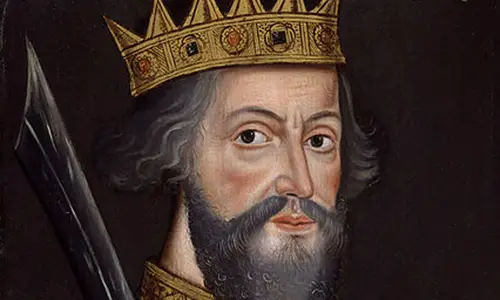1. William the Conqueror was the first Norman King of England. His family originally descended from the Vikings. His father was the Duke of Normandy in France. His mother was a commoner and was not married to his father. The year of his birth is uncertain. Some sources place it at 1027, others at 1028. He was born at Falaise.
2. When William was seven or eight years old, his father died. He was the sole heir, but because he was born out of wedlock, he was surrounded by conspiracies to depose him. Many of his guardians were killed. The King of France, King Henry I, protected him in the early years.
3. William grew up to be a suspicious and harsh individual. These qualities served him well as a military leader. He put down revolts in the neighboring areas in the Battle of Val-es Dunes and conquered Brittany and Maine. Later, when King Henry I joined forces with Geoffrey Martel to attack William, he defeated them as well.
4. William married Matilda, the daughter of the Count of Flanders. The marriage helped him to consolidate his power, as the Count was an influential noble.
5. His claim to the throne of England was surrounded by controversy. He was related to King Edward the Confessor, the English Monarch. He declared that King Edward promised him the throne. King Edward’s nephew, Harold Godwinson, was also a contender to the throne of England. But William got an opportunity to help Harold and seized it to make Harold take a holy oath to support him. When King Edward died, Harold was crowned King of England; and William readied his forces to attack him. Some accounts state that the Pope supported William because of Harold’s blasphemous perjury.
6. As William was waiting for favorable sailing conditions to set out from France, Harold was attacked by the Norwegian army. William arrived in England and built a castle at Hastings. Harold repelled the Norwegian attack and immediately led his army to Hastings. After a fierce fight, Harold was killed. The Battle of Hastings in 1066 marked the beginning of Norman rule in England.
7. The English lords did not take kindly to their new king. William dealt with them severely. He burned the areas around before attacking his enemies. This policy is known as the Harrying of the North. He confiscated lands and distributed them to his loyalists.
8. William the Conqueror did not speak English, nor was he highly educated. Despite this, he commissioned a detailed account of most of the lands under his rule, including population and livestock. This is the Domesday Book, which still exists in the Public Records Office in London.
9. Castles were an important part of William’s war strategy and became a symbol of Norman power. He built many castles, keeps, and mottes. The early castles were constructed simply of mud and wood. They were later replaced with stone. William also indulged his great fondness for hunting by preserving vast areas of land for game. New Forest is an example of this.
10. The Bayeux Tapestry is an ode to William’s ascent from Duke of Normandy to King of England. It was probably commissioned by William’s half-brother, Bishop Odo, and was displayed in Bayeux Cathedral in 1077. It is not really a tapestry but is embroidered in wool. It measures 70 meters by 50 cms, consisting of nine linen panels sewn together. There are about fifty scenes starting with King Edward and concluding with Harold’s defeat in the Battle of Hastings.
11. William the Conqueror’s legacy is impressive. Every English King or Queen since his reign is his direct descendant. The Norman influence on the language then spoken gave birth to the English in common use today. Though William did not interfere with most institutions, he imposed the Norman feudal system, with the King at its head. Lastly, the Normans proved to be excellent administrators, and this was beneficial to the country of their adoption.











Leave a Reply